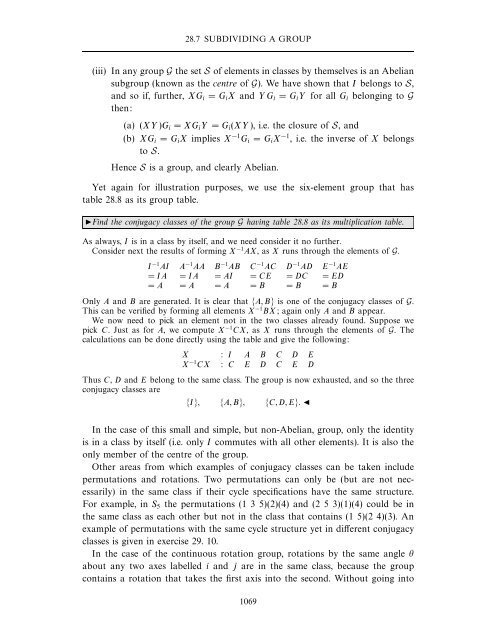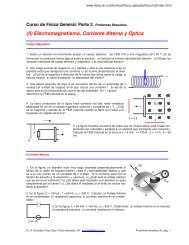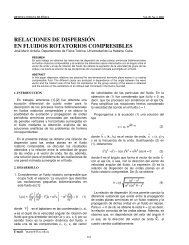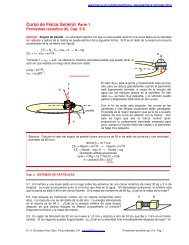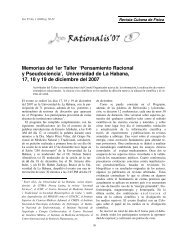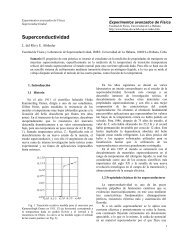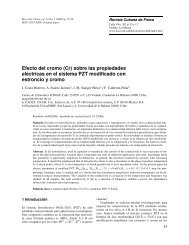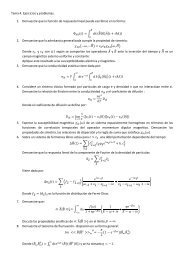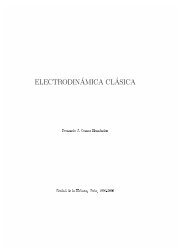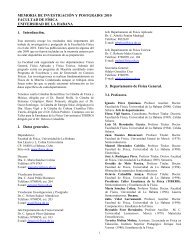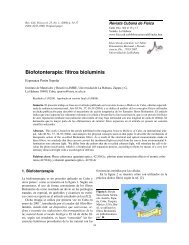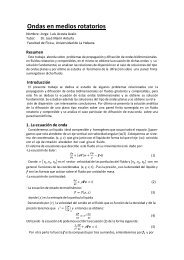Group theory
Group theory
Group theory
You also want an ePaper? Increase the reach of your titles
YUMPU automatically turns print PDFs into web optimized ePapers that Google loves.
28.7 SUBDIVIDING A GROUP(iii) In any group G the set S of elements in classes by themselves is an Abeliansubgroup (known as the centre of G). We have shown that I belongs to S,and so if, further, XG i = G i X and Y G i = G i Y for all G i belonging to Gthen:(a) (XY )G i = XG i Y = G i (XY ), i.e. the closure of S, and(b) XG i = G i X implies X −1 G i = G i X −1 , i.e. the inverse of X belongsto S.Hence S is a group, and clearly Abelian.Yet again for illustration purposes, we use the six-element group that hastable 28.8 as its group table.Find the conjugacy classes of the group G having table 28.8 as its multiplication table.As always, I is in a class by itself, and we need consider it no further.Consider next the results of forming X −1 AX, as X runs through the elements of G.I −1 AI A −1 AA B −1 AB C −1 AC D −1 AD E −1 AE= IA = IA = AI = CE = DC = ED= A = A = A = B = B = BOnly A and B are generated. It is clear that {A, B} is one of the conjugacy classes of G.This can be verified by forming all elements X −1 BX; again only A and B appear.We now need to pick an element not in the two classes already found. Suppose wepick C. Just as for A, we compute X −1 CX, as X runs through the elements of G. Thecalculations can be done directly using the table and give the following:X : I A B C D EX −1 CX : C E D C E DThus C, D and E belong to the same class. The group is now exhausted, and so the threeconjugacy classes are{I}, {A, B}, {C, D, E}. In the case of this small and simple, but non-Abelian, group, only the identityis in a class by itself (i.e. only I commutes with all other elements). It is also theonly member of the centre of the group.Other areas from which examples of conjugacy classes can be taken includepermutations and rotations. Two permutations can only be (but are not necessarily)in the same class if their cycle specifications have the same structure.For example, in S 5 the permutations (1 3 5)(2)(4) and (2 5 3)(1)(4) could be inthe same class as each other but not in the class that contains (1 5)(2 4)(3). Anexample of permutations with the same cycle structure yet in different conjugacyclasses is given in exercise 29. 10.In the case of the continuous rotation group, rotations by the same angle θabout any two axes labelled i and j are in the same class, because the groupcontains a rotation that takes the first axis into the second. Without going into1069


